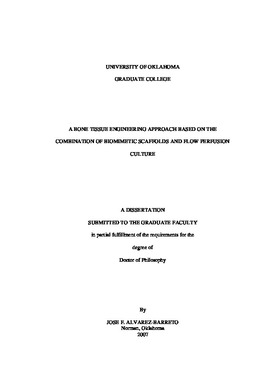| dc.contributor.advisor | Sikavitsas, Vassilios I., | en_US |
| dc.contributor.author | Alvarez-barreto, Jose F. | en_US |
| dc.date.accessioned | 2013-08-16T12:21:01Z | |
| dc.date.available | 2013-08-16T12:21:01Z | |
| dc.date.issued | 2007 | en_US |
| dc.identifier.uri | https://hdl.handle.net/11244/1303 | |
| dc.description.abstract | Bone tissue engineering has progressively emerged as a response to the current limited replacement therapies for damaged or lost bone tissue. Ideally, the implanted construct should aid in complete bone regeneration in a reasonably short time, without causing significant inconvenience to the patient. General tissue engineering approaches are based on three different bioactive factors: scaffolding, a cellular component, and a molecular component. These factors are closely conjoined to create successful constructs and fit into a bone tissue engineering paradigm that includes the extraction of a cellular biopsy from a healthy site of the patient. Cells are then expanded in vitro and seeded onto the scaffold. The cell-scaffold construct is cultured under mechanical and/or chemical stimuli for a certain amount of time so as to allow the in vitro secretion of a bone-like extracellular matrix (ECM). This construct, which now possesses an osteoinductive nature due to the secreted ECM, is implanted in the defective site for bone regeneration. The main objective of the present research project was to create an integral tissue engineering approach that combines both mechanical and chemical stimulation by. To fulfill this goal, four major steps were successfully carried out. First, a dynamic scaffold seeding technique based on oscillatory flow perfusion that improved initial cellular distribution throughout the scaffold surface, and cell-matrix interactions was developed. Secondly, a biomimetic poly(L-lactic acid scaffold) with improved cell adhesion using RGD peptides that could additionally allow the evaluation of the effect of different modification levels on cell adhesion, proliferation and differentiation was created. Thirdly, the oscillatory flow perfusion seeding of these RGD-modified scaffolds was characterized. And lastly, the effect of the level of RGD scaffold modification on the osteoblastic differentiation of mesenchymal stem cells when cultured under conditions of flow perfusion was evaluated. What makes this approach unique is the combination of mechanical and chemical stimulation of mesenchymal stem cells to direct them towards an osteoblastic path. This combinatorial approach resulted more successful than those based on chemical or mechanical stimulation alone. | en_US |
| dc.format.extent | xvi, 217 leaves : | en_US |
| dc.subject | Engineering, Biomedical. | en_US |
| dc.subject | Tissue engineering. | en_US |
| dc.subject | Engineering, Chemical. | en_US |
| dc.subject | Bone regeneration. | en_US |
| dc.subject | Biomimetic polymers. | en_US |
| dc.title | A bone tissue engineering approach based on the combination of biomimetic scaffolds and flow perfusion culture. | en_US |
| dc.type | Thesis | en_US |
| dc.thesis.degree | Ph.D. | en_US |
| dc.thesis.degreeDiscipline | School of Chemical, Biological and Materials Engineering | en_US |
| dc.note | Adviser: Vassilios I. Sikavitsas. | en_US |
| dc.note | Source: Dissertation Abstracts International, Volume: 69-01, Section: B, page: 0478. | en_US |
| ou.identifier | (UMI)AAI3291936 | en_US |
| ou.group | College of Engineering::School of Chemical, Biological and Materials Engineering | |
